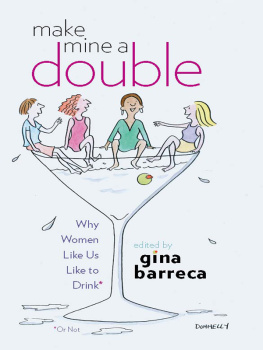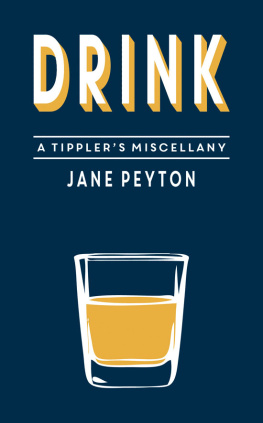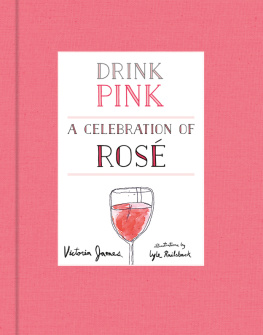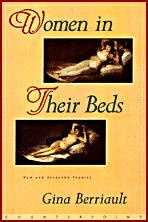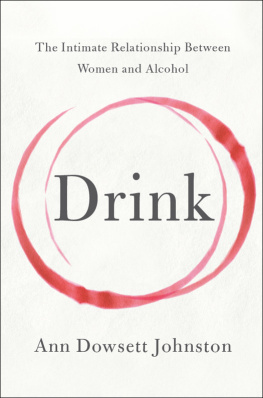Gina Barreca - Make Mine a Double: Why Women Like Us Like to Drink (Or Not)
Here you can read online Gina Barreca - Make Mine a Double: Why Women Like Us Like to Drink (Or Not) full text of the book (entire story) in english for free. Download pdf and epub, get meaning, cover and reviews about this ebook. year: 2011, publisher: University Press of New England, genre: Art. Description of the work, (preface) as well as reviews are available. Best literature library LitArk.com created for fans of good reading and offers a wide selection of genres:
Romance novel
Science fiction
Adventure
Detective
Science
History
Home and family
Prose
Art
Politics
Computer
Non-fiction
Religion
Business
Children
Humor
Choose a favorite category and find really read worthwhile books. Enjoy immersion in the world of imagination, feel the emotions of the characters or learn something new for yourself, make an fascinating discovery.
- Book:Make Mine a Double: Why Women Like Us Like to Drink (Or Not)
- Author:
- Publisher:University Press of New England
- Genre:
- Year:2011
- Rating:4 / 5
- Favourites:Add to favourites
- Your mark:
- 80
- 1
- 2
- 3
- 4
- 5
Make Mine a Double: Why Women Like Us Like to Drink (Or Not): summary, description and annotation
We offer to read an annotation, description, summary or preface (depends on what the author of the book "Make Mine a Double: Why Women Like Us Like to Drink (Or Not)" wrote himself). If you haven't found the necessary information about the book — write in the comments, we will try to find it.
Bottoms up! This landmark celebration of women and drink chips away at traditional images of gender, one ice-cube at a time.
Gina Barreca: author's other books
Who wrote Make Mine a Double: Why Women Like Us Like to Drink (Or Not)? Find out the surname, the name of the author of the book and a list of all author's works by series.
Make Mine a Double: Why Women Like Us Like to Drink (Or Not) — read online for free the complete book (whole text) full work
Below is the text of the book, divided by pages. System saving the place of the last page read, allows you to conveniently read the book "Make Mine a Double: Why Women Like Us Like to Drink (Or Not)" online for free, without having to search again every time where you left off. Put a bookmark, and you can go to the page where you finished reading at any time.
Font size:
Interval:
Bookmark:
Why
Women
Like Us
Like to
Drink*
edited by
*Or Not.
University Press of New England
Hanover and London
University Press of New England | www.upne.com | 2011 University
Press of New England | All rights reserved | Manufactured in the
United States of America | Designed by Eric M. Brooks | Typeset
in Whitman and Verlag by Passumpsic Publishing
For permission to reproduce any of
the material in this book, contact
Permissions, University Press
of New England, One Court
Street, Suite 250,
Lebanon NH 03766;
or visit
www.upne.com
Library of
Congress
Cataloging-in
Publication
Data appear
on the last
printed
page
of this
book.
5
4
3
2
1
t here I was, standing with a group of distinguished women at a Modern Language Association party a few years back, and I couldn't help but notice that our male colleagues all seemed to be holding martinis. It was quite a sight: two hundred men in blue blazers and tan trousers, all holding triangular glasses. Surveying the room, one of my colleagues wondered aloud why a man with a drink thinks he looks like Sean Connery from Dr. No, whereas a woman with a drink fears she looks like Elizabeth Taylor from Who's Afraid of Virginia Woolf? That said, she sipped her Chardonnay in silence.
Not one of us could come up with a snappy answer.
Why does the cultural cork pop when we put women together with the grape and grain? Why are there still raised eyebrows, pursed lips, and hand placed over the glass as if to signal enough?
For the most part, books about drink celebrate the social drinking of workingmen or guys in blue blazers. The titles for such books include words such as jaunty, urbane, and beer pong. In contrast, the titles for books about women who drink include words like depraved, licentious, and ignoring risks for the unborn child. Older whiskey and younger women still symbolize an accomplished man, whereas the iconic drinking woman is memorialized in Hogarth's engraving Gin Lane. Shamelessly inebriated, the drunken central figure helps herself to tobacco from a snuffbox, blissfully unaware that her baby is slipping over the staircase banister.
Women have been raised and praised to make decisions based on what's best for other people. Drinkingany amountdoes not pair well with this mission of selflessness. Gin Lane's wench, besotted by alcohol, neglects her doomed child. And so will we all, if we drink.
A woman is always teetering on the edge, about to fall into the abyss of self-indulgence. One glass too manyeven just one glasscould push her right over.
We were taught to fear the loss of control that comes from too much drink. The seduction of liquor leads to other temptations, red and juicy like an apple, and it's a downhill spiral from there. Susan Campbell writes: If I had been a drinker in high school, I would have gone home with the first guy who asked, borne three or four woods colts (that's what we called children born outside of wedlock then), and ended up for life in a trailer just outside of town. That's all from that first sip of Bud. We see how easy it is to go from a teen's first sip of beer to Elizabeth Taylor's drunken floozy Martha, a woman so fueled by drink that she humiliates her husband by sleeping with their guestor worse, the soused mom of bastard children.
Theseand so many othercautionary tales about the woman who drinks always have unhappy endings. She ends up sad, fat, abandoned, and poor. Or she ends up debauched, her looks gone, her reputation and liver in equal shades of graying disintegration. Drunk, she is a bad wife and worse mother. The glue that cements the family, she herself has become unglued, and everything falls apart.
We were also taught to bear up, button up, and deny ourselves pleasure. We must master the art of self-denial and role modeling. We should live smug and petulant lives, the lives of those who merely inflict virtue on others. We should give ourselves up, like Joan of Arc to the flames, to our passion for abstinence.
Actually, Joan of Arc, the sainted warrior, was no teetotaler; in her diaries she records her taste for sops, or bowls of bread soaked in wine. Perhaps the fear is this: if a woman is permitted happiness, she might also pursue delightand what will happen to her if she becomes too accustomed to pleasure?
She might seek it on her own, without asking for permission or benediction. Since a woman ordering a drink is the quintessential embodiment of a woman pleasing nobody but herself, it's not surprising that she's potentially a pariah. A woman with corkscrew in hand is indulging an appetite with no benefit to anyone else; she's also vaguely threatening. She drinks the way a cat purrs, not to please or entertain others, but simply for her own satisfaction. I'm not talking about self-medication; I'm talking about pleasure. The difference between enjoying your cocktails and being a drunk is the difference between enjoying a nap and being narcoleptic. Some, though, find it easier to assume that such a distinction doesn't exist.
Curiously, it isn't only patrician men who uphold this argument. Pantaloon-clad temperance ladies who chanted things like, Lips that touch liquor shall never touch mine! were the precursors to the neoconservative antifeminists of today. They're the preservers of the ideals of pure womanhooda figment of our cultural imagination contrived by a society that refuses to admit that many of its female members are actually human beings capable of making choices and acting in their own best interests. The Angel in the House, they insist, would no more sip a spritzer than she'd laugh out loud. These gatekeepers offer cold nonsense and keep emotion at arm's length, judging and preaching, refusing to accept that women's lives, like the lives of men, are often unsentimental and sometimes savage, filled with harsh circumstances, long nights, unreturned love, betrayal, bloodshed, and loss many times over, even if the women have gotten married, given birth, and followed the men's high standards of womanhood. These women cannot be thought to serve a strictly male agenda because, really, they are a breed apart. Somehow with drink, as with sex, it is supposed to be the woman's job to say no, thank you, I'm not a bit interested evenor especiallywhen she is. For too long, women have been encouraged to consider the denial of pleasure as an achievement.
The works gathered in this volume throw down a collective gauntlet to what I regard as a deeply scary cult of Nouveau Puritans who would police what women consume under the guise of helping them curb their own appetites. Apparently offering to safeguard women, what the cultists would actually like to do is place women in quarantinebut whether to protect them or to protect others from them is never quite clear.
Yet women have always managed to drink, often quite joyfully. Peasant women drink merrily in paintings by Breugel and van Dyck. Classy dames advertise French champagne. Victorian photographs show everyone from queens of England nursing their schnapps to Molly and Becky and Lily down at the Union Hall, throwing back beers with their fellow workers. By the 1920s, the flapper gets into the act. She cuts her hair, takes off forty-six pounds of undergarments and trades them for short silk skirts, goes dancing without a chaperone, and knocks down cocktails as if drinking were a spectator sport. Finally women were drinking spirits publicly, unapologetically, and withto somequite shocking pleasure. This new woman standing at the bar became a metaphor for a woman standing everywhere else she was not meant to be: the voting booth, the university library, the birth-control clinic.
Font size:
Interval:
Bookmark:
Similar books «Make Mine a Double: Why Women Like Us Like to Drink (Or Not)»
Look at similar books to Make Mine a Double: Why Women Like Us Like to Drink (Or Not). We have selected literature similar in name and meaning in the hope of providing readers with more options to find new, interesting, not yet read works.
Discussion, reviews of the book Make Mine a Double: Why Women Like Us Like to Drink (Or Not) and just readers' own opinions. Leave your comments, write what you think about the work, its meaning or the main characters. Specify what exactly you liked and what you didn't like, and why you think so.

